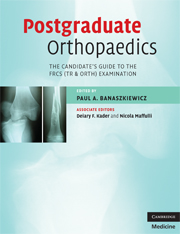Book contents
- Frontmatter
- Contents
- List of contributors
- Foreword by Mr Peter Gibson
- Preface
- Glossary
- Section 1 The FRCS (Tr & Orth) examination
- 1 General guidance
- Section 2 The written paper
- Section 3 The clininicals
- Section 4 Adult elective orthopaedics oral
- Section 5 The hand oral
- Section 6 The paediatric oral
- Section 7 The trauma oral
- Section 8 The basic science oral
- Section 9 Miscellaneous topics
- Index
1 - General guidance
from Section 1 - The FRCS (Tr & Orth) examination
Published online by Cambridge University Press: 22 August 2009
- Frontmatter
- Contents
- List of contributors
- Foreword by Mr Peter Gibson
- Preface
- Glossary
- Section 1 The FRCS (Tr & Orth) examination
- 1 General guidance
- Section 2 The written paper
- Section 3 The clininicals
- Section 4 Adult elective orthopaedics oral
- Section 5 The hand oral
- Section 6 The paediatric oral
- Section 7 The trauma oral
- Section 8 The basic science oral
- Section 9 Miscellaneous topics
- Index
Summary
The FRCS Orth examination is generally considered to be fair although very searching and stressful. It is a major obstacle and hurdle to negotiate during higher specialist orthopaedic training. The syllabus is very broad and so the examiners can ask anything they really want to. About 6–12 months of hard work will be required beforehand if you wish to face the examiners with some degree of confidence over the green baize table.
The aims of the examination are to see if you have sufficient knowledge to become a consultant orthopaedic surgeon and be able to practise safely. Much of the examination can be passed with the knowledge and skills acquired during everyday training, unfortunately it does have to be backed up with a broad knowledge base. The written paper is now referred to as section I and the clinicals and orals as section II. The written paper is now a separate examination held several weeks before the clinicals and orals. The written paper format has been changed to multiple choice questions (MCQs) and extended matching item questions (EMIs) and has to be successfully passed before a candidate is allowed to sit the clinicals and orals. The MCQ/EMI paper is regarded as more difficult to pass than the old style written paper as it tests a much larger breadth and depth of orthopaedics.
- Type
- Chapter
- Information
- Postgraduate OrthopaedicsThe Candidate's Guide to the FRCS (TR & Orth) Examination, pp. 3 - 6Publisher: Cambridge University PressPrint publication year: 2008



